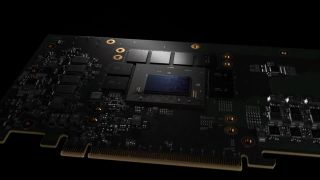Intel shows off its Arctic Sound-M datacentre GPU
It's set to power streaming and cloud gaming platforms.

During its recent 'Vision' event, Intel shared details on its upcoming Arctic Sound-M (ATS-M) GPU. ATS-M is Intel’s general-purpose datacentre GPU. It’s designed for compute and transcoding operations and its set to form the backbone of Intel and its clients’ streaming and cloud gaming services.
ATS-M will come in two versions, with respective TDPs of 75W and 150W. It’s designed to be a flexible and scalable solution for cloud providers. A single card can support up to eight 4K streams, or more than 30 1080p streams per card, which means up to 120 streams per node or 13,000 per rack.
The card that Intel displayed is a single slot passive card. That means it's designed to be used in a high density, high airflow datacentre environment. By itself, ATS-M would not offer stellar gaming performance, but when you pack tens of thousands of them together, there’s no reason that Intel can’t become a leader in cloud GPU services. Of course, that all depends on the particulars of the platform, software user interface and something that the public won’t be privy to, the pricing.
Notably, ATS-M supports AV1 encoding, which is set to become a widely used standard for streamers, content providers, and creators. As AV1 becomes more widely used by streaming services, the need for AV1 hardware support could give Intel an important advantage in the short to medium term. AV1 encoding support is also set to be offered by Arc desktop GPUs.

Best CPU for gaming: The top chips from Intel and AMD
Best gaming motherboard: The right boards
Best graphics card: Your perfect pixel-pusher awaits
Best SSD for gaming: Get into the game ahead of the rest
The other interesting application for ATS-M GPUs is cloud gaming. Will these GPUs power the mysterious Project Endgame? Though it hasn’t been talked about a lot, this could be a future Intel cloud gaming service, or perhaps a client service that’s powered by Intel infrastructure.
At the Vision event, Intel talked about the accelerating growth of cloud gaming. It estimates the cloud gaming market to have a value of around $3.2 billion in 2026. This includes Windows and Android cloud gaming services. Nvidia and Microsoft have bet big on the GeForce Now and Xbox cloud gaming services. And then there’s the metaverse. Growth in cloud applications will require huge amounts of computing power in order to run seamlessly.
Arctic Sound-M is already sampling to customers and it has been validated for use in at least fifteen designs. We can expect more news on its applications around the time of its scheduled release in the third quarter of 2022.
The biggest gaming news, reviews and hardware deals
Keep up to date with the most important stories and the best deals, as picked by the PC Gamer team.

Chris' gaming experiences go back to the mid-nineties when he conned his parents into buying an 'educational PC' that was conveniently overpowered to play Doom and Tie Fighter. He developed a love of extreme overclocking that destroyed his savings despite the cheaper hardware on offer via his job at a PC store. To afford more LN2 he began moonlighting as a reviewer for VR-Zone before jumping the fence to work for MSI Australia. Since then, he's gone back to journalism, enthusiastically reviewing the latest and greatest components for PC & Tech Authority, PC Powerplay and currently Australian Personal Computer magazine and PC Gamer. Chris still puts far too many hours into Borderlands 3, always striving to become a more efficient killer.
Most Popular






